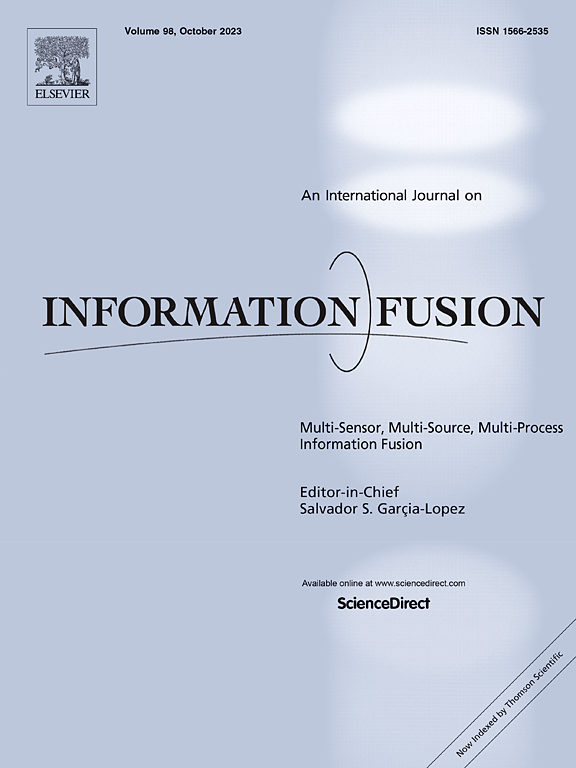基于时间记忆融合的通用预训练惯性信号特征提取
IF 14.7
1区 计算机科学
Q1 COMPUTER SCIENCE, ARTIFICIAL INTELLIGENCE
引用次数: 0
摘要
惯性传感器广泛应用于智能手机、机器人、可穿戴设备、航空航天系统和工业自动化。然而,从惯性信号中提取通用特征仍然是一个挑战。惯性信号特征编码为抽象的、不可读的波形,缺乏图像的视觉直观性,给语义提取带来困难。非平稳性和复杂的运动模式进一步使特征提取过程复杂化。此外,缺乏大规模带注释的惯性数据集限制了深度学习模型学习通用特征并将其推广到惯性传感器的广泛应用中。为此,我们提出了一种用于一般惯性信号特征提取的拓扑引导特征提取(TG-FE)方法。TG-FE将时间序列信息融合到图形表示中,通过模拟人类记忆的复杂网络特征构建记忆图。在小世界网络原则的指导下,该图集成了局部和全局信息,而稀疏性约束强调关键特征的相互作用。Memory Graph保留了非线性关系和高阶依赖关系,使模型能够以最小的特定于任务的调优实现跨场景的泛化。此外,交叉图特征融合机制集成了堆叠TG-FE模块间的信息,增强了表达能力,保证了梯度流的稳定。通过自我监督的预训练,TG-FE模块只需要很小的微调就可以适应各种硬件配置和任务场景,在所有评估中始终优于比较方法。与目前最先进的方法相比,我们的TG-FE在姿态和位移估计任务中实现了11.7%和20.0%的误差降低。值得注意的是,TG-FE在稳定性评估方面取得了数量级的优势,即使在20%噪声条件下,竞争方法也会显著下降,仍能保持稳健的性能。总的来说,这项工作为一般惯性信号特征提取提供了一种解决方案,并为应用基于图的深度学习来捕获和表示序列信号特征开辟了新的途径。本文章由计算机程序翻译,如有差异,请以英文原文为准。
General pre-trained inertial signal feature extraction based on temporal memory fusion
Inertial sensors are widely used in smartphones, robotics, wearables, aerospace systems, and industrial automation. However, extracting universal features from inertial signals remains challenging. Inertial signal features are encoded in abstract, unreadable waveforms, lacking the visual intuitiveness of images, which makes semantic extraction difficult. The non-stationary nature and complex motion patterns further complicate the feature extraction process. Moreover, the lack of large-scale annotated inertial datasets limits deep learning models to learn universal features and generalize them across expansive applications of inertial sensors. To this end, we propose a Topology Guided Feature Extraction (TG-FE) approach for general inertial signal feature extraction. TG-FE fuses time-series information into graph representations, constructing a Memory Graph by emulating the complex network characteristics of human memory. Guided by small-world network principles, this graph integrates local and global information while sparsity constraints emphasize critical feature interactions. The Memory Graph preserves nonlinear relationships and higher-order dependencies, enabling the model to generalize across scenarios with minimal task-specific tuning. Furthermore, a Cross-Graph Feature Fusion mechanism integrates information across stacked TG-FE modules to enhance representation ability and ensure stable gradient flow. With self-supervised pre-training, the TG-FE modules require only minimal fine-tuning to adapt to various hardware configurations and task scenarios, consistently outperforming comparison methods across all evaluations. Compared to the current state-of-the-art method, our TG-FE achieves 11.7% and 20.0% error reduction in attitude and displacement estimation tasks. Notably, TG-FE achieves an order-of-magnitude advantage in stability evaluations, maintaining robust performance even under 20% noise conditions where competing methods degrade significantly. Overall, this work offers a solution for general inertial signal feature extraction and opens new avenues for applying graph-based deep learning to capture and represent sequential signal features.
求助全文
通过发布文献求助,成功后即可免费获取论文全文。
去求助
来源期刊

Information Fusion
工程技术-计算机:理论方法
CiteScore
33.20
自引率
4.30%
发文量
161
审稿时长
7.9 months
期刊介绍:
Information Fusion serves as a central platform for showcasing advancements in multi-sensor, multi-source, multi-process information fusion, fostering collaboration among diverse disciplines driving its progress. It is the leading outlet for sharing research and development in this field, focusing on architectures, algorithms, and applications. Papers dealing with fundamental theoretical analyses as well as those demonstrating their application to real-world problems will be welcome.
 求助内容:
求助内容: 应助结果提醒方式:
应助结果提醒方式:


